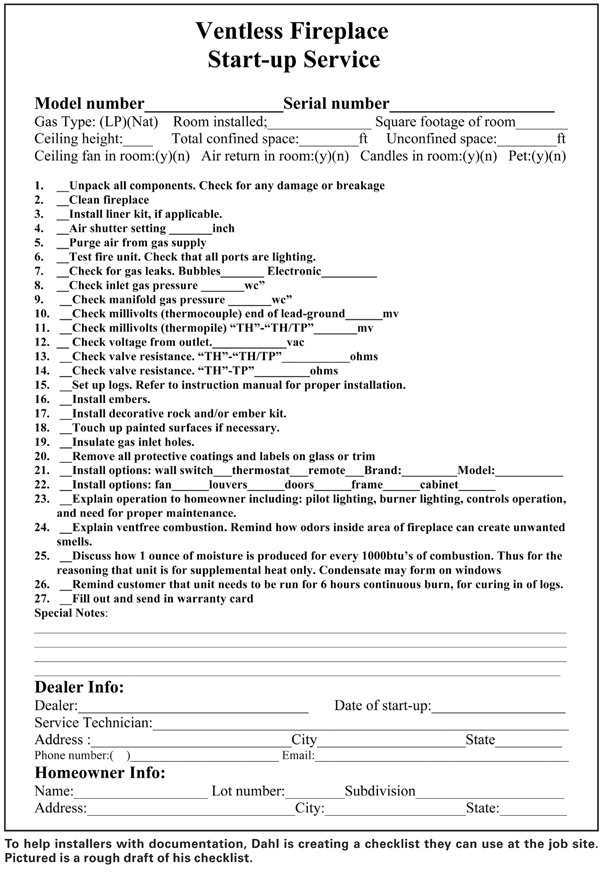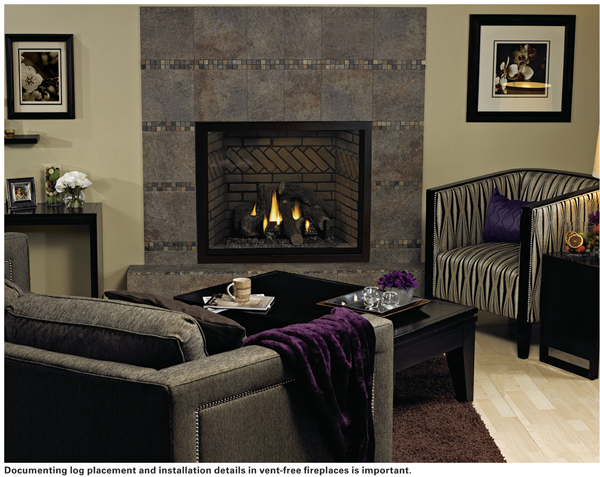Thursday, April 2, 2015
“Cover Your Assets.” That’s what the “CYA” stands for in Rich Dahl’s upcoming National Propane Gas Association (NPGA) Southeastern Conference session titled, “CYA Service Call: How to Handle the Problem Customer.” Dahl, who is national service trainer for Empire Comfort Systems (Belleville, Ill.), said documentation is a key part of his presentation because of its extreme importance in today’s litigious society and in dealing with difficult customers. Speaking to BPN in advance of his April presentation, he noted that installers should document nearly everything they encounter at a customer’s residence, including ceiling fans, pets, odorants, and even perfume or cologne use by a customer. He explained that vent-free products use room air, and odorants in the air could become re-burnt through a vent-free product and cause an unpleasant smell.
“I had one customer who wore a lot of perfume. That was a problem within the fireplace,” Dahl explained. “There are a lot of things you have to look for.” He has been in the hearth industry for 25 years and has seen all types of service call situations during his 10 years with Empire Comfort Systems. The company sells gas-fired products including vented, vent-free, and B-vent heaters and fireplaces; vented and vent-free log sets, and fireplace inserts and cast iron stoves. Most of the products run on propane or natural gas. His presentation will focus primarily on vent-free products and the importance of documenting everything when installing those products.
He has been in the hearth industry for 25 years and has seen all types of service call situations during his 10 years with Empire Comfort Systems. The company sells gas-fired products including vented, vent-free, and B-vent heaters and fireplaces; vented and vent-free log sets, and fireplace inserts and cast iron stoves. Most of the products run on propane or natural gas. His presentation will focus primarily on vent-free products and the importance of documenting everything when installing those products.
On a service call, Dahl begins documenting the moment he enters the residence. He makes sure the product he is installing is sized correctly for the house, and he documents items such as ceiling fans and candles that can create problems with vent-free products. Ceiling fans can change the flame pattern of the vent-free product and can result in extra soot in the fireplace.
He documents whether the house has pets, which can mean hair in the fireplace that could also cause trouble. He reports on the new appliance’s position within the house, making a notation of the side of the house—east, for example—where the appliance will be located. “There’s a lot more than just installing the vent-free product and walking away from it,” he pointed out.
And of course, installers should document the model and serial number of the product to be installed. Make sure it’s running on the correct gas pipe at the correct pressure.
“That gives us a precise account of when that product was made, how long ago it was made, and who made the product.”
Documenting log placement with vent-free fireplaces is important, and that is best done with pictures. After the installation, customers often want to rearrange the logs, but that can cause problems. Taking photos to document the log placement before leaving an installation site can help the dealer or installer when the customer later complains of trouble with the appliance. Dahl also uses photos to document where the fireplace is positioned in the room. If the room has tall, vaulted ceilings or is in an area where perpendicular walls are close to the fireplace, that can affect the unit’s operation. His presentation also covers direct-vent fireplaces and will address a new American National Standards Institute (ANSI) code, which states that any direct-vent glass-faced fireplace with a glass-front temperature of 172ºF or more must have a protective barrier front installed on it to protect young children and others from serious burns. Empire uses a barrier from Quanex Building Products that Dahl describes as similar to a window screen.
His presentation also covers direct-vent fireplaces and will address a new American National Standards Institute (ANSI) code, which states that any direct-vent glass-faced fireplace with a glass-front temperature of 172ºF or more must have a protective barrier front installed on it to protect young children and others from serious burns. Empire uses a barrier from Quanex Building Products that Dahl describes as similar to a window screen.
His session at the Southeastern event will also include wood, because many customers choose to install gas log sets into wood-burning fireplaces. Installers must determine whether the fireplace is approved for a gas log set. Even though the installer is simply placing a set of logs into a wood-burning fireplace, the materials around that fireplace must be non-combustible. If the residents decide they do not want to burn gas anymore and want to go back to burning wood, that fireplace must be able to be returned to its original condition.
“There are so many different things that guys take for granted when it comes to an install,” stated Dahl, who conducts service schools as lead trainer for Empire Comfort Systems. “In the old school it was, install it, get it done, get paid. But there need to be a few extra things documented on it…that’s really the message of this whole thing.”
To help installers with documentation, he is creating a checklist they can use at a job site (see p. 26). They can document everything they have checked at the job site and every task they have performed, such as checking air shutter settings and gas pressure and documenting when they installed a screen on the fireplace and whether the residence has candles or pets, all in a single page they can reference if the customer has problems later.
“The one thing I tell these guys is if for some reason you do get called back in a litigation situation in court, that will happen usually two or three years after you’ve been at a job site. If you try to go off of memory, you get hurt. That’s why documentation and pictures are so important. You’ve got the recollection of it and it shows everything so you can cover yourself.”
—Daryl Lubinsky
“I had one customer who wore a lot of perfume. That was a problem within the fireplace,” Dahl explained. “There are a lot of things you have to look for.”

On a service call, Dahl begins documenting the moment he enters the residence. He makes sure the product he is installing is sized correctly for the house, and he documents items such as ceiling fans and candles that can create problems with vent-free products. Ceiling fans can change the flame pattern of the vent-free product and can result in extra soot in the fireplace.
He documents whether the house has pets, which can mean hair in the fireplace that could also cause trouble. He reports on the new appliance’s position within the house, making a notation of the side of the house—east, for example—where the appliance will be located. “There’s a lot more than just installing the vent-free product and walking away from it,” he pointed out.
And of course, installers should document the model and serial number of the product to be installed. Make sure it’s running on the correct gas pipe at the correct pressure.
“That gives us a precise account of when that product was made, how long ago it was made, and who made the product.”
Documenting log placement with vent-free fireplaces is important, and that is best done with pictures. After the installation, customers often want to rearrange the logs, but that can cause problems. Taking photos to document the log placement before leaving an installation site can help the dealer or installer when the customer later complains of trouble with the appliance. Dahl also uses photos to document where the fireplace is positioned in the room. If the room has tall, vaulted ceilings or is in an area where perpendicular walls are close to the fireplace, that can affect the unit’s operation.

His session at the Southeastern event will also include wood, because many customers choose to install gas log sets into wood-burning fireplaces. Installers must determine whether the fireplace is approved for a gas log set. Even though the installer is simply placing a set of logs into a wood-burning fireplace, the materials around that fireplace must be non-combustible. If the residents decide they do not want to burn gas anymore and want to go back to burning wood, that fireplace must be able to be returned to its original condition.
“There are so many different things that guys take for granted when it comes to an install,” stated Dahl, who conducts service schools as lead trainer for Empire Comfort Systems. “In the old school it was, install it, get it done, get paid. But there need to be a few extra things documented on it…that’s really the message of this whole thing.”
To help installers with documentation, he is creating a checklist they can use at a job site (see p. 26). They can document everything they have checked at the job site and every task they have performed, such as checking air shutter settings and gas pressure and documenting when they installed a screen on the fireplace and whether the residence has candles or pets, all in a single page they can reference if the customer has problems later.
“The one thing I tell these guys is if for some reason you do get called back in a litigation situation in court, that will happen usually two or three years after you’ve been at a job site. If you try to go off of memory, you get hurt. That’s why documentation and pictures are so important. You’ve got the recollection of it and it shows everything so you can cover yourself.”
—Daryl Lubinsky



